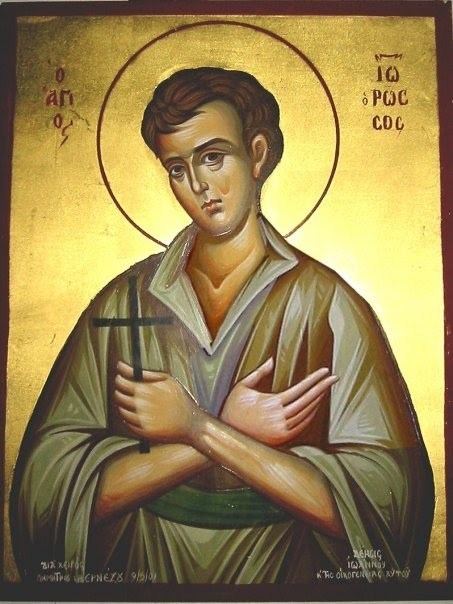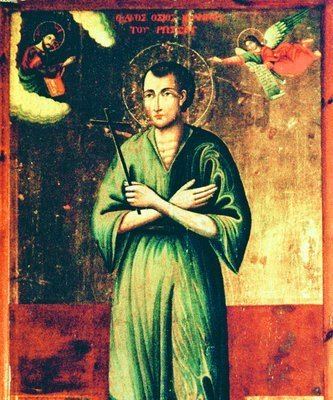Name John Russian | Feast June 9/May 27 Role Saint | |
 | ||
Died May 27, 1730, Urgup, Turkey | ||
Saint john the russian full documentary greek english subtitles
Saint John the Russian (Ukrainian: Ioan Rus'kii, Russian: Ioann Russkii) (1690, Cossack Hetmanate (modern Ukraine) – May 27 (N.S. June 9), 1730) is one of the most renowned saints in the Greek Orthodox Church. Being a prisoner of war and a slave to a Turkish Agha, he became famous and respected even by his Muslim master for his humility, steadiness in faith and benevolence. His holy relics are undecayed and wonder-working; there are traditions that this saint particularly helps sick children and those who suffer from cancer.
Contents
- Saint john the russian full documentary greek english subtitles
- Prokopi Evia The church of Saint John the Russian
- Youth
- Life in Slavery
- Beginning of reverence
- Holy Places Worth Visiting
- References

Prokopi, Evia: The church of Saint John the Russian
Youth

St John the Russian was born approximately in 1690 in Ukraine. Having come of age, he was recruited to the army of Peter the Great and took part in the Russo-Turkish War (1710–1711). During the war he was captured prisoner and sold to slavery to the head of Turkish cavalry.
Life in Slavery
The saint refused to adopt Islam and was humiliated and tormented for that by the Turks, who called him a kafir, which means "unbeliever". But as the time went by, the mockery had stopped due to saint's steadiness in faith, humility and diligence, and saint John became respected by his master and the household. He worked as a groom and lived in the stables. Other slaves mocked him for the zeal he was working with, but the pious man took no offence, trying to help them in their needs and comforting them when needed. For his sincere kind-heartedness, the saint had earned love and trust of the Agha who proposed him to live as a free man, in separate house. But he refused, saying: "My patron is Lord, and no one is above Him. He predestined me to live as a slave in a foreign land; seems, it must be so for my salvation".

In the daytime John worked and prayed, keeping strict fast, and when the night came, he used to go secretely to the cave-church of St. George, where he said the prayers of All-Night Vigil. Every Saturday he used to take the Holy Communion.
Soon the Agha became rich and one of the most influential people in Urgup. He decided, that it is due to the holy man, who lives in his home. Having become rich, the Agha decided to carry out the Hajj. During this travel, his wife was giving a dinner to the relatives and friends. When the master's favourite dish, pilau was being served, she told John, who was waiting upon the table: "How glad would your master be, if he could eat this pilau with us". The saint asked her to give him this dish, promising to send it to Mecca. Everybody was laughing, but John's request was complied, they decided he wanted to eat pilau himself or give it to the poor.
When the Agha came back, he told about the miracle that had happened to him: while being in Mecca, he found a fuming plate of pilau in his locked room. And on this plate his name was engraved - as on every plate in his home.
Beginning of reverence
News of this miracle spread quickly, and everyone, even Muslims, began to call John a "Wali" - a "saint". However, he didn't change the way he lived, and spent time doing hard work and praying. Before his death he became seriously ill and, having no ability to stand up, asked for a priest to give him the Holy Communion. The priest was afraid to openly go to a Muslim house and hid the Eucharist inside an apple. John the Russian died on June 9, 1730, some time after receiving the Holy Communion.
Holy Places Worth Visiting
The relics of saint John are in Church of Saint John the Russian in (Prokopi) in Euboea, Greece. His right hand is in Russian Monastery of St Panteleimon on Athos. By blessing of Patriarch Alexy II of Moscow in 2003-2004 a small wooden church of St. John the Russian was erected in Moscow, in Kuntsevo district. In Novosibirsk, Russia the lower side chapel of the church of Our Lady of the Sign is also devoted to St. John the Russian. There is also a small private wooden chapel (tsasouna) of St. John the Russian in Viljakkala (Ylojarvi municipality) in Finland.
